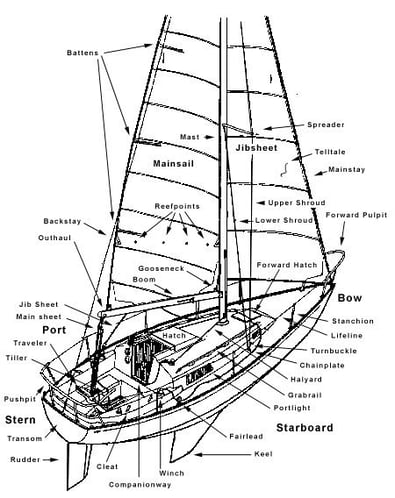“To reach a port we must set sail – Sail, not tie at anchor. Sail, not drift.” Franklin D. Roosevelt
I love this very famous Roosevelt's quote that has helped me sail through and buoyed me up to successfully navigate business waters. What I had then not expected was that running a boat would enable me to learn the ropes of effective business management.
My first time sailing was whilst on holiday in Port Douglas. My partner arranged for a day trip on a sail boat, to which we were invited to help the crew in the operation of the vessel. I was hooked immediately.
I began sailing in early 2019 with a competent crew course through Allsail at Pittwater, and now I enjoy this sport on a weekly basis. When it comes to process management and team performance, few sports can claim to have had such a big influence on me as Sailing. It is amazing as to how many of the lessons are transferable to the workplace.
6 items that crossover from sailing into good business include:
1 - Common terminology allows for effective communication and easy onboarding (pun intended)
In sailing every component of a boat has a specific name which is common across the global and allows for you to easily work with other crew members and give clear directions in the usual fast passed environment.

Source: Illustration by Mark Smith, from John Rousmaniere’s THE ANNAPOLIS BOOK OF SEAMANSHIP, published by Simon & Schuster
The same could be said for having a well structured onboarding program for new employees which teaches them the system in the organisation in a well organised manner, reducing the overall time needed for onboarding.
Action items:
- Identify jargon that is necessary for new hires to understand and document this in an easily consumable format.
- Review your onboarding program to ensure it addresses the following:
- Activities prior to the first day including organising equipment, access to systems and setting up payroll information
- Introduction to colleagues and key department managers, depending on the size of the organisation book in time for the managers to explain what their department does
- Organise for the employee to get exposure to the relevant functions in the business including participating in sales, marketing, quality control and service delivery over the first couple of weeks
- Consider using software such as Enboarder, Trainual or Confluence
2 - Bum on boat time > lengthy documents
You can read dozens of books about sailing covering all of the theory from points of sail to mooring but it is far more effective to get out there and do it under the supervision of someone experienced than it is to read about it.
The same can be said for getting an employee up to speed with the responsibilities in their role.
Action items:
- Archive any lengthy documents that you're including as part of an induction pack for new employees -
- Create brief summaries that reinforce the key points for processes that employees are involved in that can supplement
- Have a clear list of items that you want the employees supervisor to show them and verify that they can perform the task
3 - Its not always going to be business as usual and you need a Plan B
Wind is a requirement for sailing and even with all of the technology we have the predictions can be wrong and you will end up with next to no wind so you need a plan to deal with the abnormal situations that arise. This could also be loss of the diesel inboard engine requiring a crew to sail back to the marina.
In business, you will need a plan in place to address common situations such as:
- Loss of key staff
- Information systems crash (e.g. disruption to Dropbox or Gmail)
- Loss of office/warehouse
- Theft of company assets (e.g. vehicles, computers and records)
Action items:
- Identifying the situations in advance and thinking about the steps that would be taken to continue running the business if those situations arise is the key.
- Create a short Business Continuity Plan which outlines response strategies for the identified situations
4 - Set and forget isn't for the real world
On a boat there is that blissful moment where you're getting a decent amount of wind, the sails have been trimmed and everything is smooth sailing but as the tell tales will show there is always room for improvement and if you keep monitoring the tell tales you'll be able to anticipate it rather than deal with it reactively.

Photo credit: Sailing World
It is no different in business, without effective monitoring and measurement of your processes, you are only going to be reactively dealing with issues as they arise rather than proactively adjusting to manage them. Examples of critical items to monitor and measure in business are:
- Cashflow - forecasts based on past data
- Sales pipeline - an accurate projection of expected sales
- Work in progress (WIP) - current work you're expected to deliver and the resources allocated against the expected projects that are coming up to identify any resource shortfalls
- Client satisfaction - regular check ins with clients to ensure that what is being delivered is in line with client expectations set in the sales process
- Service quality - internal reviews of work delivered against the requirements for the project including client, legal and internal policy and procedures
Action items:
- Determine the critical items relevant to your business that need to be monitored and measured (e.g. for professional services, this could be billable percentage, while in manufacturing it might be stock levels)
- Set a baseline for where the metrics should be and where the organisation is working to get them to in consultation with the relevant managers
- Break the metrics down to be relevant to the various levels in the organisation down to individuals (where possible)
- Consider using software such as Cascade
5 - Something always breaks
You may have purchased a new sail boat and undertake all of the mandatory maintenance with the best care but something always breaks, this is no different to a business. There will never be a point in business where nothing is broken and if you leave it, the issue will only get worse, so it is always recommended to spend the time identifying the issues and resolving them now.
Keeping track of these issues and implementing corrective actions that not only resolves it, but looks at preventing it again in the future is necessary.
Action items:
- Establish a culture of reporting issues and recording them in an agreed upon format, whether that is using software such as JIRA or a more manual process, making sure it is consistent
- Identify trends in reported issues and prioritise the implementation of corrective action that targets the root cause of the issue with the aim of preventing it from occurring again
- For significant issues or trends, ensure that lessons learnt are shared throughout the organisation and included as part of the onboarding program for new employees
6 - Understand the external environment
Your Customers are your nautical charts - understand them well.
In racing, competitors are useful as you can see what decisions they are making and immediately find out if it is the right decision or not, which can be used to improve your decisions. It is the same in business, you can see how competitors are positioning themselves, what feedback they are receiving from the market and then take that into account as part of your decision making to take advantage of gaps in the market.
You also have to take external issues that are out of your control into account when planning. In sailing, this usually involves reviewing the weather forecasts for items such as wind and reviewing the course you are going to follow to ensure that the depth is suitable.

Source: PredictWind App
It is no different in business, you can't make effective decisions without understanding external context of the organisation taking into account political, economic, societal, technological, environment and legal factors. Identifying these factors and then determining if any action needs to be taken to address these issues is a must have.
Action items:
- Set a regular review of the external issues that you have previously identified and use it as an opportunity to identify any changes in these issues or the actions to address them
- Document the external issues and make this available to relevant employees in the organisation so that they are aware of it
- Consider combining this assessment with a SWOT Analysis
Good sailors and good businesses are defined by how they handle the lulls and how efficient their operations are.
In conclusion, there are many aspects that crossover between good sailing and good business.
The key difference is that missteps in sailing usually have immediate and obvious consequences while it may not be so obvious in business. Applying the action items outlined in this article in your business will not only improve the management of the business but put you on track to also comply with standards such as ISO 9001 Quality Management System Requirements and ISO 45001 Occupational Health and Safety Management Systems.


.jpg)
